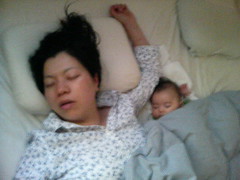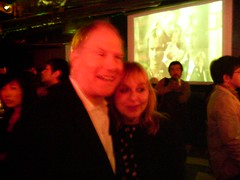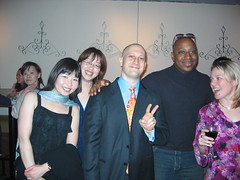Had a good practice this evening. First, I managed to show up almost on time -- we started about 7:30 and trained for a good 1.5 hours. There a shiny fresh beginner on the floor (her second class) so I had her go through the basic basics whilst the rest of the class did their typical thing. At some point the theme became (I never manage to figure out what we're practicing until we start and get well into it) moving from one's center. There are lots of fancy ways to describe this, and several really, really talented martial artists who have perfected it (Kuroda Tetsuzan, etc.) but I like to keep things simple. The basic ideas are: stay balance at all times, reduce all unnecessary movement, remain flexible. All three are linked, and really one can't be done without the other two.
Staying balanced means just that; don't wobble like you're going to fall over. Keep your upper body over your lower body (or keep your lower body under your upper body.) Be aware of your left and right, your front and back, and whichever direction you move, make sure all your parts are cooperating, otherwise you end up swaying, tilting, dragging.
Reducing all unnecessary movement leads to the surprising yet ultimately intuitive conclusion that many things you do with your body to get it acting are really pointless. Straightening the ankle, forcing the foot to push off the ground and drive the leg/hip/body forward is a really silly way to start taking a step. Why use such a small muscle in the ankle to move the whole body? Instead, just keep the leg relaxed, pick it up using the large muscles in the butt and thigh, and get it moving from the hip. After that, the whole body will follow. The corollary is: use big muscles for big movements, small muscles for small movements. To take a step forwards, use the butt, thigh, and hips. To swing the sword, use the back and hips. To adjust the angle of the
kissaki a millimeter, use the fingers and wrist. Also, you need to use the whole body together as one. In order to bring the sword overhead, if you're already stepping forward, you are in a sense stepping under your sword already, so there's no need to use the arm the bring the sword over your head, too. Use the wrist and arm to get the sword moving back, in conjunction with the body moving forwards.
Finally, flexibility is key to acting and reacting. The human body is really, really bad at staying still. Anything other than positions of natural rest are hard to keep; opposing muscles fight each other to tighten and stretch in opposite directions. Instead of trying to be rock embedded in the floor, be molten lava, dune of sand, flowing river, tempestuous wind. Even standing water in a calm lake is fluid; try grabbing a handful of it. Much harder than grabbing ice cubes. Being flexible starts with the knees; keep them bent and more importantly, bending. In order to keep the hips stable (giving you a good platform from which to move), the lower body needs to be like coiled springs or shock absorbers. No matter how the body moves, the knees must bend or straighten in order to keep the body balanced and moving efficiently.
Also, tension in muscles causes fatigue, and makes it harder to move in different directions; a tightly bent arm is tough to bend more, and really isn't a very good starting point for straightening out either. Tension in muscles usually means tension in demeanor, too. Staying flexible of body and mind means not expecting anything, and therefore means you are able to react to anything, to move in any direction.
Keeping the mind calm keeps the body supple; keeping the body relaxed quites the mind.


